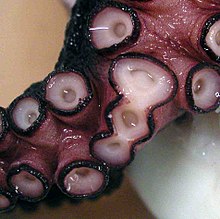Arm of Illex illecebrosus with two rows of suckers along its length
Tentacle of Illex illecebrosus with a distal tentacular club (right)










All cephalopods possess flexible limbs extending from their heads and surrounding their beaks. These appendages, which function as muscular hydrostats, have been variously termed arms, legs or tentacles.[A]
- ^ Thomas, David (12 August 2008). "Octopuses have two legs and six arms". The Telegraph. Retrieved 30 July 2018.
To most of us it has always seemed obvious that an octopus has eight arms. Octopuses have two legs and six arms Claire Little, a marine expert from the Weymouth Sea Life Centre in Dorset, said: 'We've found that octopuses effectively have six arms and two legs.'
- ^ Ruth A., Byrne; Kuba, Michael J.; Meisel, Daniela V.; Griebel, Ulrike; Mather, Jennifer A. (August 2006). "Does Octopus vulgaris have preferred arms?". Journal of Comparative Psychology. 120 (3): 198–204. doi:10.1037/0735-7036.120.3.198. PMID 16893257.
- ^ Lloyd, John; Mitchinson, John (2010). QI: The Second Book of General Ignorance. London: Faber and Faber. p. 3. ISBN 978-0571273751.
As result, marine biologists tend to refer to them as animals with two legs and six arms.
Cite error: There are <ref group=upper-alpha> tags or {{efn-ua}} templates on this page, but the references will not show without a {{reflist|group=upper-alpha}} template or {{notelist-ua}} template (see the help page).

